David Coletto
Apr 14, 2025
I spend a lot of time digging into our Abacus Data polling data, looking at trends, understanding the relationship between variables. Imagine a chef in a kitchen testing out new recipes. That’s me in a dataset, and I love it! On the surface, this election campaign has been fairly uneventful. A lot of change happened before the election formally began. Carney’s Liberals hold a modest lead in vote share over Pierre Poilievre’s Conservatives. But the regional results suggest the Liberals are on track for a majority victory.
Jagmeet Singh’s NDP and Yves-François Blanchet’s Bloc Québécois are struggling to find traction. But beneath the horse race, there’s something quite remarkable unfolding—something that points to Carney’s unusually strong popularity across a broad cross-section of Canadian voters.
To me, the most important figure that explains this election today is Mark Carney’s net favourable rating. In an age of heightened polarization, growing regional divides, and global uncertainty—especially with U.S. President Donald Trump’s recent tariff announcements and even outlandish talk of annexing Canada as the 51st state—Carney’s ability to maintain and even grow his personal popularity may well be the central story of this campaign.
A Brief Overview of the Polling Environment
Let’s start with where things stand. According to our most recent survey, the Liberals currently hold a four-point lead over the Conservatives nationally. That might not seem like a huge advantage, but when we break down the numbers regionally, we see a more nuanced picture: the Liberals are doing especially well in Ontario, Quebec, and Atlantic Canada, and they remain competitive in British Columbia. The Conservatives, as expected, remain dominant in much of the Prairies and rural parts of the country, but they have yet to capitalize on any major issue to make up ground elsewhere. Meanwhile, the NDP vote has collapsed and BQ have fallen back.
What’s striking, however, is how Canadians feel about Mark Carney personally. Typically, two weeks before election day, net favourable ratings of party leaders - especially incumbent ones - have either plateaued or started to slip. People have usually had enough time to form concrete opinions. Indeed, in most campaign cycles, negativity creeps in as opposition parties, media scrutiny, and the pressures of campaigning reveal vulnerabilities in a leader. But that hasn’t happened this time—at least, not yet.
Instead, Carney has seen his positives increase over the course of the campaign, while his negatives have stayed largely flat or, in some demographics, even decreased. That’s rare.
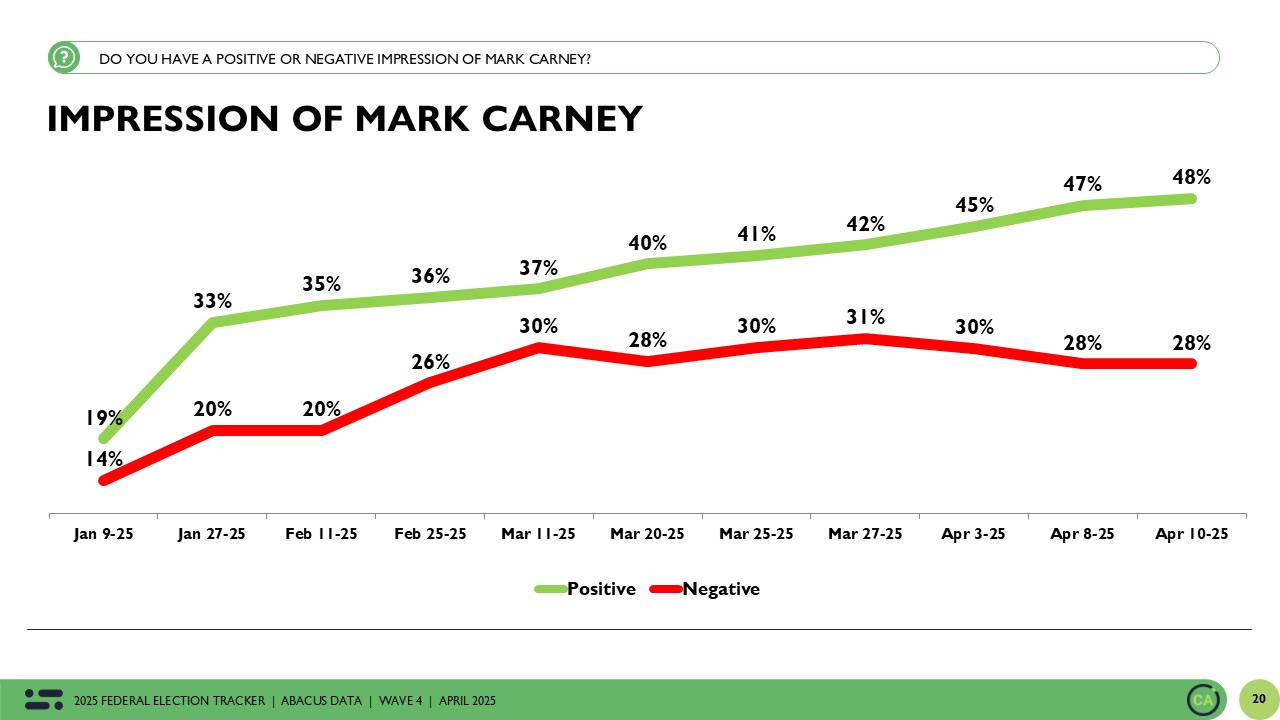
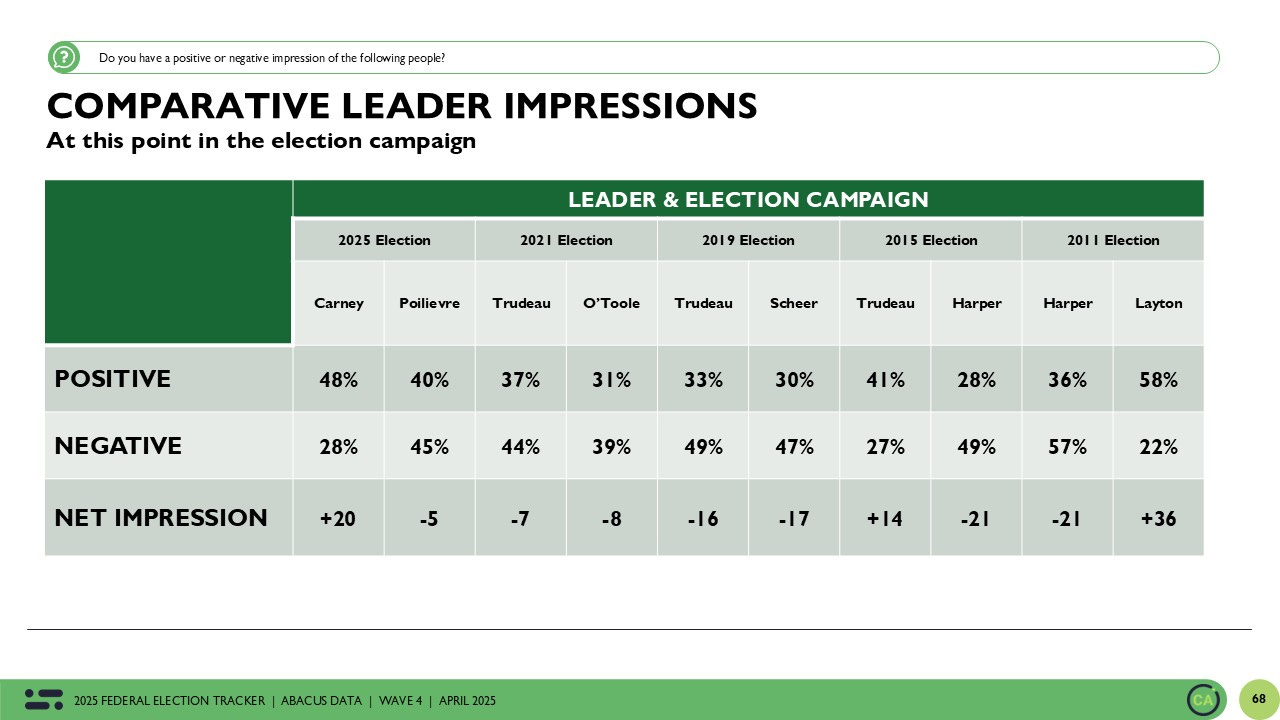
The breakdown by region is particularly telling:
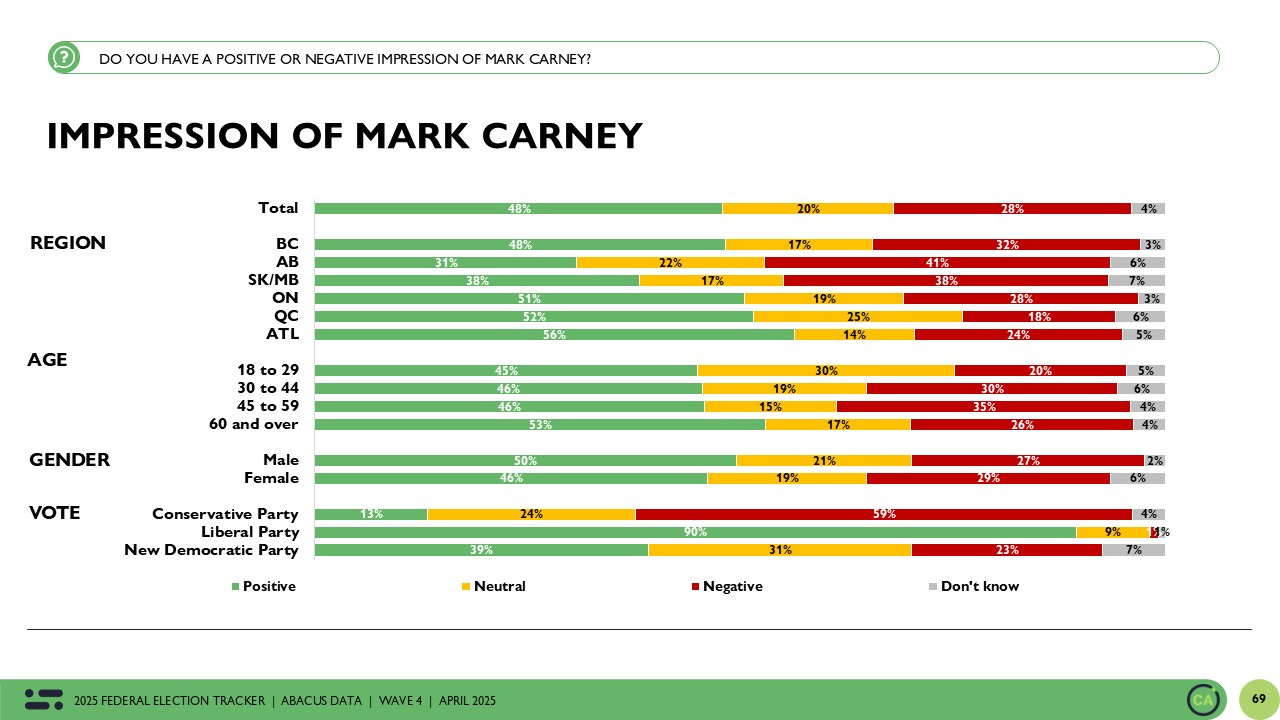
Carney also seems to be well-liked across gender lines, which is no small feat in today’s political climate. While male voters historically lean Conservative, and female voters often tilt Liberal or NDP, Carney’s positive impressions are high among both men and women. That’s the kind of universal acceptance that’s extremely hard to come by, especially for incumbents seeking re-election.
Perhaps the most noteworthy data point is how Carney is viewed by Conservative voters themselves. Although only 13% of Conservative supporters currently hold a positive view of him, it’s significant that more than one in ten Conservative partisans are willing to admit they like the Prime Minister. By contrast, 59% of Conservative voters say they have a negative view of Carney—but we need to put that into context. In the 2015 election, Justin Trudeau, who went on to form a majority government, had similar (though slightly higher) negative impressions among Conservative partisans. At that point in the campaign, 19% of Conservative voters had a positive impression of Trudeau, while 55% had a negative impression. Carney’s numbers are in the same ballpark, suggesting that while he may not be winning over many Conservative voters, he’s also not deeply disliked by everyone in that camp. This is a far cry from the hyper-partisanship we have seen in the last two federal elections.
Share
When we break down attitudes by educational attainment, the Prime Minister’s popularity seems to spike even more. Among Canadians with a university degree, Carney enjoys a net favourable of +31. This correlates closely with the Liberals’ traditional base in more urban, educated communities and is a big part of why the party continues to dominate in key ridings across urban and suburban Canada.
Even among those who say they “definitely want to see a change in government,” Carney still posts some surprisingly resilient numbers: 26% have a positive impression, compared to 51% who hold a negative view. While those who are itching for change are more negative than positive, that one-quarter chunk of potential swing voters indicates Carney isn’t uniformly despised by those who are seeking a new government.
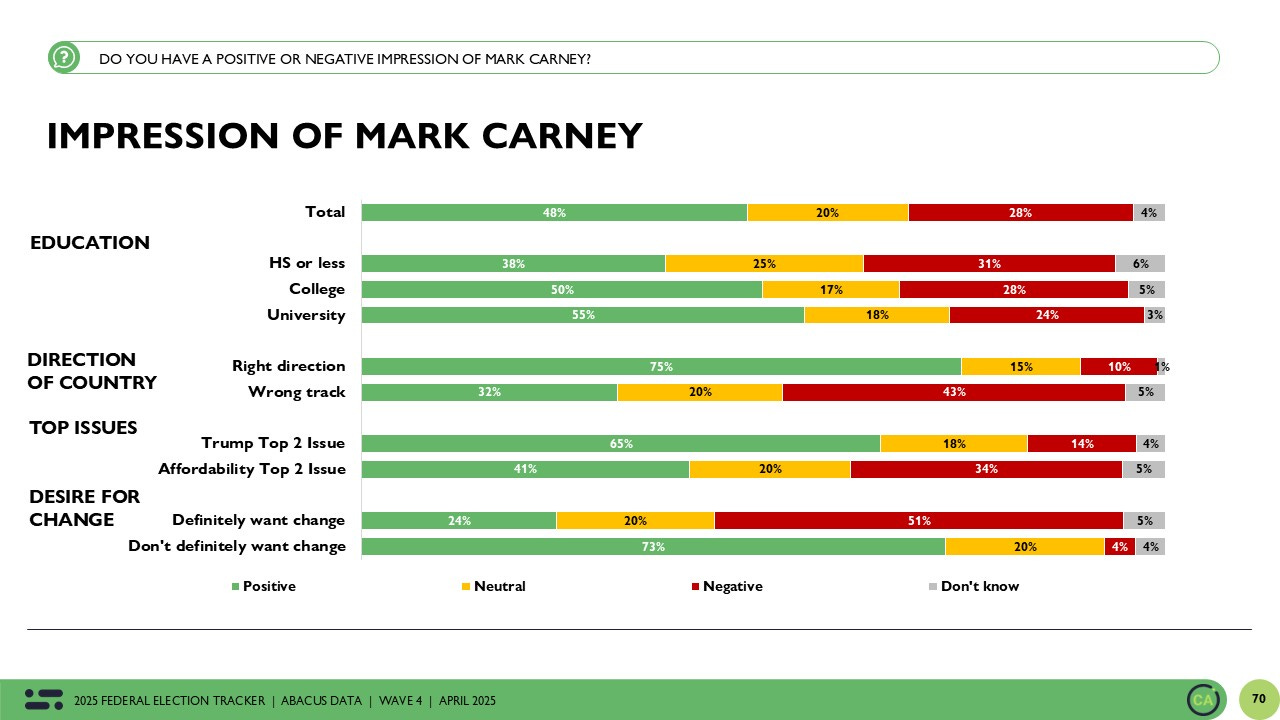
Moreover, this campaign has been overshadowed by other issues, primarily Donald Trump’s erratic behaviour south of the border. His threats of annexing Canada and sudden tariff impositions have diverted attention away from the usual mudslinging at home. It appears that Carney’s steady, measured response to Trump’s unpredictability has only bolstered his image as a reliable leader who navigates global uncertainty with calmness. Is it harder for mud to stick when Canadians are projecting positive vibes on the new Prime Minister?
From a purely strategic standpoint, if Poilievre or other opposition leaders were hoping to capitalize on affordability or trade anxieties, Trump’s theatrics may have inadvertently pushed voters to rally around the current Liberal leader instead.
Carney vs. Other Leaders Since 2011
To give historical context, Carney’s favourables are the highest we’ve seen from an incumbent this late in a campaign since Stephen Harper’s 2011 majority victory days, and even then, Harper was never particularly well-liked outside of his conservative base—he was more respected than he was personally liked. The only other federal leader who saw similarly widespread personal affection was Jack Layton in 2011, during the famous “Orange Wave.” While Carney may not be rewriting the political map to the same extent Layton did, he has a broad reservoir of goodwill.
In fact, when we line up Carney’s net favourables next to the leaders at the same point in the previous five federal elections—Trudeau in 2015, Scheer in 2019, O’Toole in 2021, and Harper/Trudeau in earlier cycles—Carney stands out. Only Layton at this point in 2011 held equally high likeability and cross-partisan appeal. And in 2015, a few weeks before his majority victory, Justin Trudeau had fairly similar numbers to Carney, but even then, not as favourable.
It’s also important to note how strong Pierre Poilievre’s favourables are compare with the last three Conservative Party leaders. At this point in the campaign, Poilievre’s positives are 9-points higher than O’Toole’s and 10-points higher than Scheer. Under normal circumstances, that would certaintly be enough to win an election. But these aren’t normal circumstances.
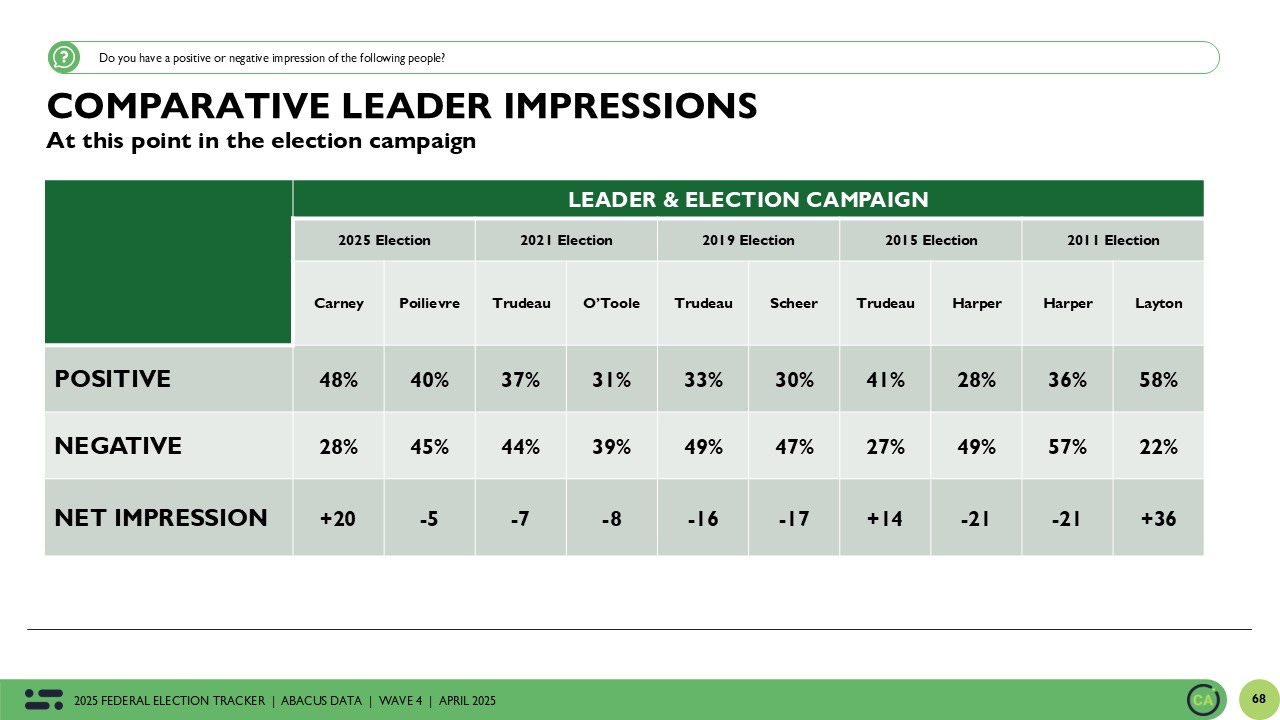
As we edge closer to election day, the challenge for the Conservatives, NDP, and BQ is clear: if they cannot pull Carney’s favourables down, they will struggle to make headway in the final stretch. Yes, campaigns can turn quickly—especially in the digital era—but with only two weeks left, time is short. If Carney’s positives remain this high, he and the Liberals will almost certainly secure enough support to form another government, likely even with a comfortable margin. History tells us that once a leader’s favourables hit a critical mass, it becomes exceedingly difficult for opponents to reverse that tide without a major scandal or misstep.
Looking at our numbers, nearly half of Canadians already have a favourable view of the Prime Minister. That alone is easily enough to win an election in Canada’s first-past-the-post system, assuming the votes are efficiently distributed. As long as Carney maintains or grows that level of personal popularity, there’s every reason to think that Canadians will stick with him when they enter the voting booth.
In other words, the story of this campaign may not be Pierre Poilievre’s inability to pivot in response to Trump’s provocations, nor the relative invisibility and collapse of the NDP . Instead, it could be the failure of all opposition parties to paint Mark Carney in a negative light. Despite the chaos brewing south of the border, Canadian voters seem largely at ease with the Liberal leader, and unless that changes in the next few days—starting with the debates—the Liberals will be in a very strong position on election night.
Apr 14, 2025
I spend a lot of time digging into our Abacus Data polling data, looking at trends, understanding the relationship between variables. Imagine a chef in a kitchen testing out new recipes. That’s me in a dataset, and I love it! On the surface, this election campaign has been fairly uneventful. A lot of change happened before the election formally began. Carney’s Liberals hold a modest lead in vote share over Pierre Poilievre’s Conservatives. But the regional results suggest the Liberals are on track for a majority victory.
Jagmeet Singh’s NDP and Yves-François Blanchet’s Bloc Québécois are struggling to find traction. But beneath the horse race, there’s something quite remarkable unfolding—something that points to Carney’s unusually strong popularity across a broad cross-section of Canadian voters.
To me, the most important figure that explains this election today is Mark Carney’s net favourable rating. In an age of heightened polarization, growing regional divides, and global uncertainty—especially with U.S. President Donald Trump’s recent tariff announcements and even outlandish talk of annexing Canada as the 51st state—Carney’s ability to maintain and even grow his personal popularity may well be the central story of this campaign.
A Brief Overview of the Polling Environment
Let’s start with where things stand. According to our most recent survey, the Liberals currently hold a four-point lead over the Conservatives nationally. That might not seem like a huge advantage, but when we break down the numbers regionally, we see a more nuanced picture: the Liberals are doing especially well in Ontario, Quebec, and Atlantic Canada, and they remain competitive in British Columbia. The Conservatives, as expected, remain dominant in much of the Prairies and rural parts of the country, but they have yet to capitalize on any major issue to make up ground elsewhere. Meanwhile, the NDP vote has collapsed and BQ have fallen back.
What’s striking, however, is how Canadians feel about Mark Carney personally. Typically, two weeks before election day, net favourable ratings of party leaders - especially incumbent ones - have either plateaued or started to slip. People have usually had enough time to form concrete opinions. Indeed, in most campaign cycles, negativity creeps in as opposition parties, media scrutiny, and the pressures of campaigning reveal vulnerabilities in a leader. But that hasn’t happened this time—at least, not yet.
Instead, Carney has seen his positives increase over the course of the campaign, while his negatives have stayed largely flat or, in some demographics, even decreased. That’s rare.

Diving Deeper into Carney’s Favourable Ratings
To understand just how unusual Carney’s popularity is, we need to look at the data more closely. Nationally, his overall impressions are the best we’ve measured for a party leader since Jack Layton in 2011. Back then, Layton was riding a wave of affection that ultimately propelled the NDP to its best-ever electoral result. Since then, no federal party leader has managed to sustain such strong, positive impressions this late in a campaign.
The breakdown by region is particularly telling:
- Atlantic Canada: Carney’s net favourable rating is +32. This is a striking figure, showing that the good feelings towards him in the Atlantic provinces have grown consistently over the campaign.
- Quebec: At +34, his net favourable in Quebec is even higher than in Atlantic Canada. While the Bloc has a base of support in the province, this data shows that a large portion of Quebecers have a soft spot for Carney—an important factor if the Liberals hope to hold onto or gain seats here. And this has happened even as questions about Carney’s french persist - but so far clearly haven’t mattered.
- Ontario: Perhaps most critical to forming a majority government, Carney sits at +23 net favourable in the country’s largest province. The Conservatives need to make big gains in Ontario, but Poilievre appears to be struggling to cut into Carney’s personal appeal among the province’s urban and suburban voters.
- British Columbia: The picture in B.C. is also quite favourable, at +16, which is substantial in a province often defined by three-way races among the Liberals, Conservatives, and NDP.
- Alberta: The one region where Carney doesn’t have a positive net rating is Alberta, where he sits at -11. Still, considering the strong Conservative tilt of the province, a -11 rating isn’t as bad as one might expect for a Liberal leader. This suggests that while he may not be everyone’s first choice in Alberta, his negatives aren’t skyrocketing in a region typically hostile to Liberal politicians.

Crossing Demographic and Political Lines
Beyond regional splits, Carney appears to be defying typical demographic fault lines. Across all age groups—whether it’s younger Canadians under 30, middle-aged voters, or older Canadians nearing retirement—Carney’s net favourables remain in positive territory. Typically, we see more volatility among younger voters, but so far, Carney’s numbers have stayed relatively stable. This cross-generational appeal points to a leader who manages to balance a forward-looking vision (appealing to younger voters) with an experienced, steady hand (reassuring older Canadians).Carney also seems to be well-liked across gender lines, which is no small feat in today’s political climate. While male voters historically lean Conservative, and female voters often tilt Liberal or NDP, Carney’s positive impressions are high among both men and women. That’s the kind of universal acceptance that’s extremely hard to come by, especially for incumbents seeking re-election.
Perhaps the most noteworthy data point is how Carney is viewed by Conservative voters themselves. Although only 13% of Conservative supporters currently hold a positive view of him, it’s significant that more than one in ten Conservative partisans are willing to admit they like the Prime Minister. By contrast, 59% of Conservative voters say they have a negative view of Carney—but we need to put that into context. In the 2015 election, Justin Trudeau, who went on to form a majority government, had similar (though slightly higher) negative impressions among Conservative partisans. At that point in the campaign, 19% of Conservative voters had a positive impression of Trudeau, while 55% had a negative impression. Carney’s numbers are in the same ballpark, suggesting that while he may not be winning over many Conservative voters, he’s also not deeply disliked by everyone in that camp. This is a far cry from the hyper-partisanship we have seen in the last two federal elections.
Share
When we break down attitudes by educational attainment, the Prime Minister’s popularity seems to spike even more. Among Canadians with a university degree, Carney enjoys a net favourable of +31. This correlates closely with the Liberals’ traditional base in more urban, educated communities and is a big part of why the party continues to dominate in key ridings across urban and suburban Canada.
Even among those who say they “definitely want to see a change in government,” Carney still posts some surprisingly resilient numbers: 26% have a positive impression, compared to 51% who hold a negative view. While those who are itching for change are more negative than positive, that one-quarter chunk of potential swing voters indicates Carney isn’t uniformly despised by those who are seeking a new government.

Why This Matters: Rare and Remarkable Favourables
These numbers are quite telling. In most campaigns, we’d expect to see higher negatives pile up against an incumbent. Opposition parties usually latch onto every opportunity—be it an economic stumble, a foreign policy mishap, or personal controversies—to cast doubt on the leader’s competence or integrity. However, Carney’s biggest liability—his background as a former central banker and Goldman Sachs executive—hasn’t turned off voters the way it could have in 2023 or 2024 (see this for why the mindset of Canadians has shifted). So far, neither the Conservatives nor the NDP have found a narrative that effectively undermines his credibility or questions his character.Moreover, this campaign has been overshadowed by other issues, primarily Donald Trump’s erratic behaviour south of the border. His threats of annexing Canada and sudden tariff impositions have diverted attention away from the usual mudslinging at home. It appears that Carney’s steady, measured response to Trump’s unpredictability has only bolstered his image as a reliable leader who navigates global uncertainty with calmness. Is it harder for mud to stick when Canadians are projecting positive vibes on the new Prime Minister?
From a purely strategic standpoint, if Poilievre or other opposition leaders were hoping to capitalize on affordability or trade anxieties, Trump’s theatrics may have inadvertently pushed voters to rally around the current Liberal leader instead.
Carney vs. Other Leaders Since 2011
To give historical context, Carney’s favourables are the highest we’ve seen from an incumbent this late in a campaign since Stephen Harper’s 2011 majority victory days, and even then, Harper was never particularly well-liked outside of his conservative base—he was more respected than he was personally liked. The only other federal leader who saw similarly widespread personal affection was Jack Layton in 2011, during the famous “Orange Wave.” While Carney may not be rewriting the political map to the same extent Layton did, he has a broad reservoir of goodwill.
In fact, when we line up Carney’s net favourables next to the leaders at the same point in the previous five federal elections—Trudeau in 2015, Scheer in 2019, O’Toole in 2021, and Harper/Trudeau in earlier cycles—Carney stands out. Only Layton at this point in 2011 held equally high likeability and cross-partisan appeal. And in 2015, a few weeks before his majority victory, Justin Trudeau had fairly similar numbers to Carney, but even then, not as favourable.
It’s also important to note how strong Pierre Poilievre’s favourables are compare with the last three Conservative Party leaders. At this point in the campaign, Poilievre’s positives are 9-points higher than O’Toole’s and 10-points higher than Scheer. Under normal circumstances, that would certaintly be enough to win an election. But these aren’t normal circumstances.

The Road Ahead: Debates and Defining Carney
With two key leaders’ debates set to take place on Wednesday and Thursday, the window of opportunity is closing for opposition parties to try to alter public perceptions of Carney. If they hope to cut into the Liberals’ support, they must find some way to shake voters’ confidence in the Prime Minister. So far, they’ve been unable to define Carney negatively—whether by attacking his academic record (at the same reminding and/or educating people that Carney has a PhD in Economics), his time as Chair of Brookfield (showing people his has business experience), or evening questioning whether Stephen Harper approved of his work at the Bank of Canada. In a way, every time they have tried to attack Carney, the information may have inadvertently informed voters of his experience or skillset - experience they may not have known but appreciate he has. The Teflon-like nature of his personal appeal might reflect Canadians’ appreciation for his competence and calm demeanour, particularly in the face of unpredictable shifts in U.S. policy.As we edge closer to election day, the challenge for the Conservatives, NDP, and BQ is clear: if they cannot pull Carney’s favourables down, they will struggle to make headway in the final stretch. Yes, campaigns can turn quickly—especially in the digital era—but with only two weeks left, time is short. If Carney’s positives remain this high, he and the Liberals will almost certainly secure enough support to form another government, likely even with a comfortable margin. History tells us that once a leader’s favourables hit a critical mass, it becomes exceedingly difficult for opponents to reverse that tide without a major scandal or misstep.
Looking at our numbers, nearly half of Canadians already have a favourable view of the Prime Minister. That alone is easily enough to win an election in Canada’s first-past-the-post system, assuming the votes are efficiently distributed. As long as Carney maintains or grows that level of personal popularity, there’s every reason to think that Canadians will stick with him when they enter the voting booth.
In other words, the story of this campaign may not be Pierre Poilievre’s inability to pivot in response to Trump’s provocations, nor the relative invisibility and collapse of the NDP . Instead, it could be the failure of all opposition parties to paint Mark Carney in a negative light. Despite the chaos brewing south of the border, Canadian voters seem largely at ease with the Liberal leader, and unless that changes in the next few days—starting with the debates—the Liberals will be in a very strong position on election night.


No comments:
Post a Comment